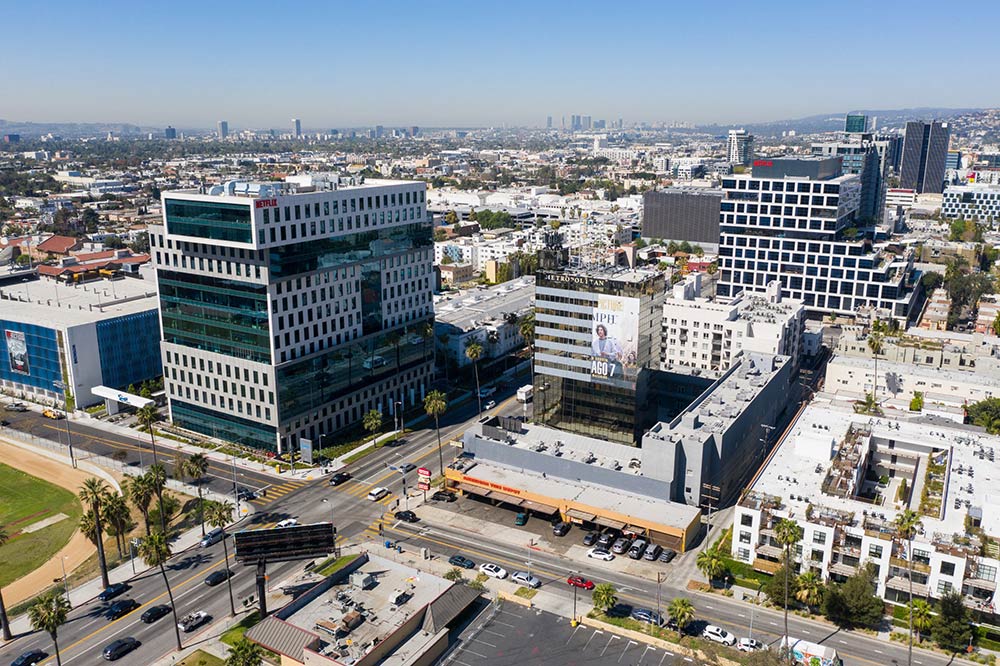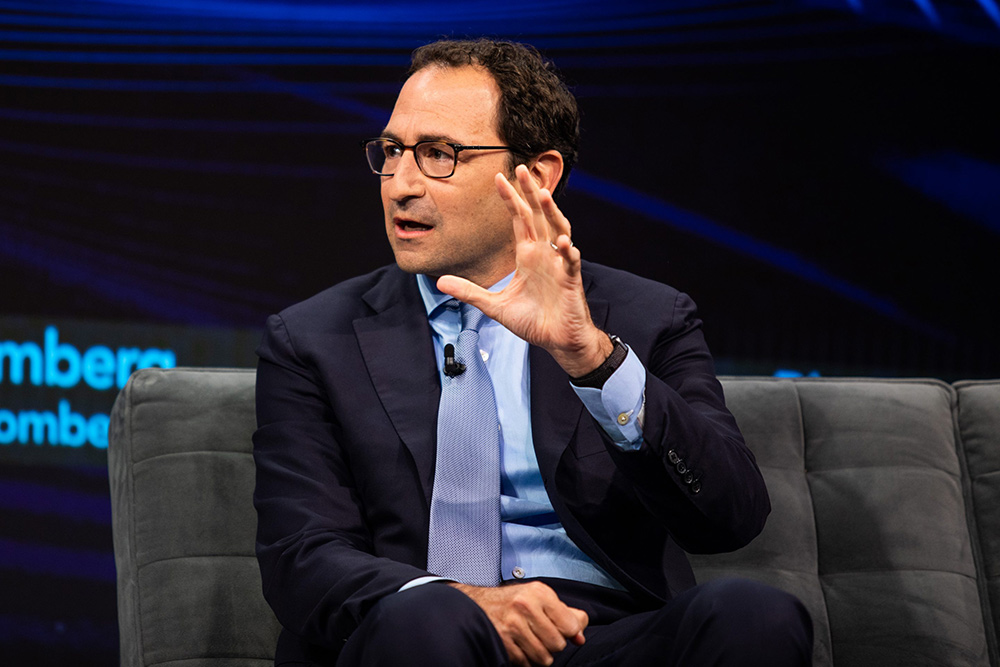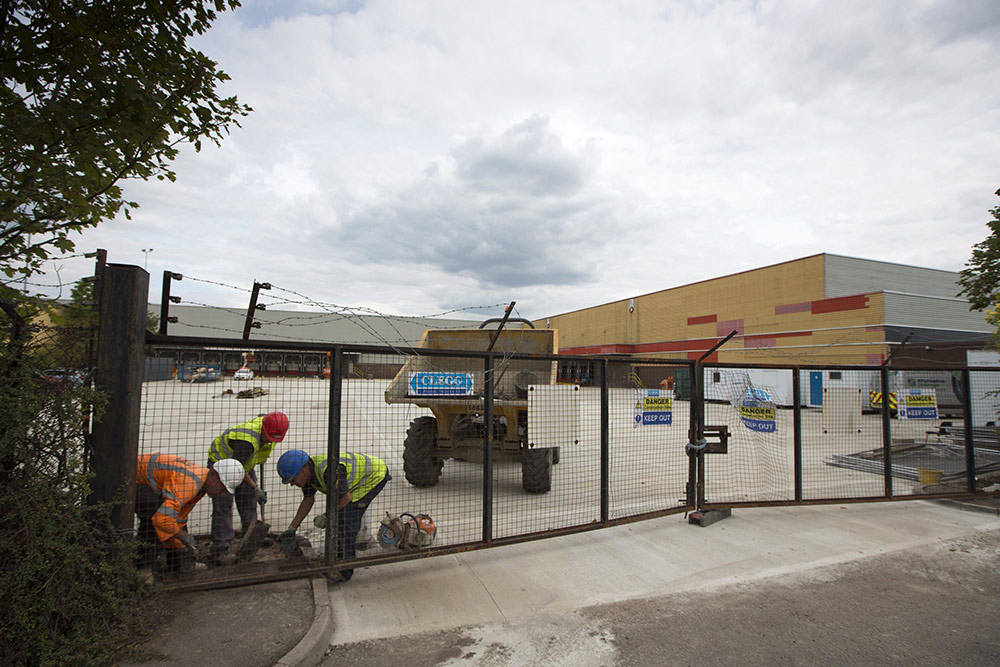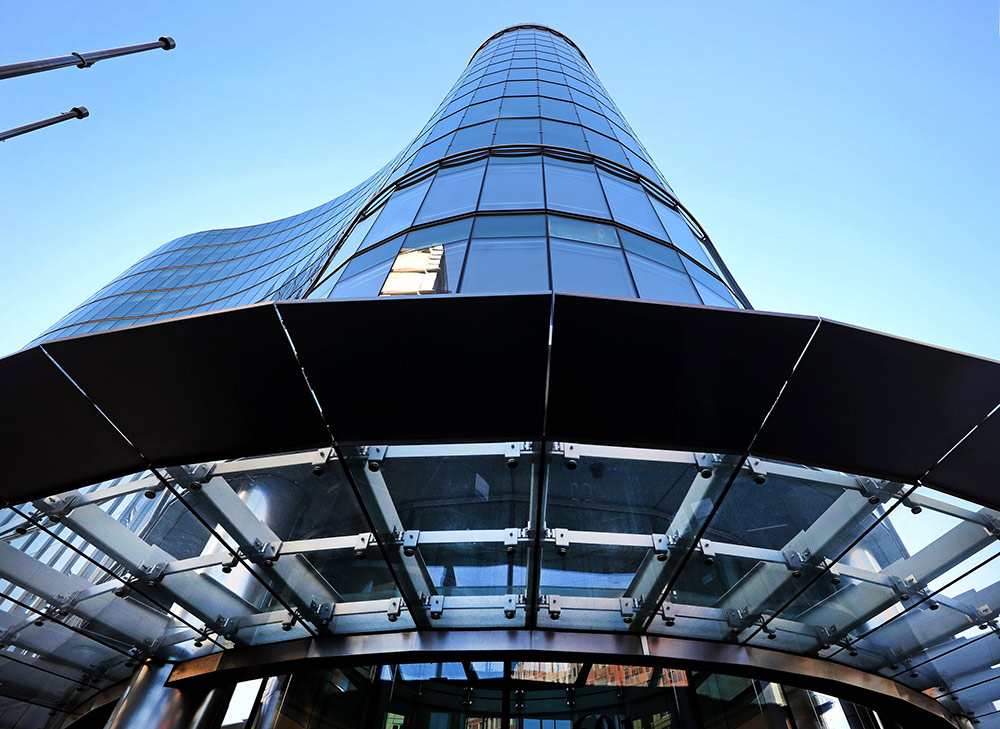6月16日,SOHO中国发布公告称,私募巨头黑石发出全面收购要约,投资SOHO中国。交易价格约为236.58亿港元(约合30.48亿美元),以取得SOHO中国的控股权。交易完成后,SOHO中国现有控股股东将保留9%的股权。
能够将SOHO中国如此大体量的盘子收入囊中的黑石,经常能够在最好的时机谈下最低的价格,且善于捕捉趋势,准确找到朝阳领域,借势得以飞速发展。
这篇文章,将回顾黑石作为全世界最大的商业地产所有者的成功之路。
就在那一刻,纳迪姆•梅格吉意识到新好莱坞电影为房地产施了法。
梅格吉在私募股权公司黑石负责美国地产投资。2019年春日的一天,他站在洛杉矶Nerflix大楼14层的屋顶露台上,俯瞰这家流媒体巨头位于日落大道上的创意总部。拥挤的停车场,成群结队的技术人员、编剧、演员和制作人从办公楼匆匆赶往低矮的摄影棚。
梅格吉的心里很清楚,眼前热闹的内容创作中心是全球最好的房地产机会之一。
“这不仅仅是办公大楼。”他回忆道。“它还是制作爆发式增长的在线娱乐内容的关键基础设施。这里是充分整合的中心,Netflix或迪士尼可以为剧本创作、拍摄、营销以及其他内容制作流程租下办公室和工作室。”
在访问期间,梅格吉和黑石团队了解到,Nexflix利用长期租约来控制节目策划和拍摄地,从而节约了巨大成本,迪士尼和亚马逊也采用了类似的集中策略。这与最近常见的零散模式有所不同,在零散模式下,电影和电视公司会授权个体制片人临时租用演出办公室和舞台。
在梅格吉看来,通过“批量出租”和“集中制作”模式来制作流媒体内容正是黑石渴望的投资类型,最好是租客业务蓬勃发展,即便租金迅速上涨,其他竞争对手也极难插手。
梅格吉从Netflix大楼顶上看到的庞大媒体综合体,正如历史悠久白色圆柱矗立的华纳兄弟总部,都属于独一无二的奇迹,而且面临的竞争极少。
因此,一年多后的2020年6月,即便在新冠疫情肆虐期间,办公室和工作室几乎空无一人,黑石还是宣布将收购洛杉矶这座大楼49%的股份,就是之前梅格吉看中的地方。交易之后,黑石成为企业的共同所有者,经营着美国最大的独立制片厂之一。
现在黑石是Netflix洛杉矶总部的房东,租客包括Netflix和迪士尼,这让黑石倍感自豪。在摄影棚里,Netflix的《厄普肖一家》(The Upshaws)和美国广播公司的《19号消防局》(Station 19)等热门剧集纷纷开机拍摄,而黑石联合持有的公司负责管理从舞台到餐食,再到灯光调试等一系列事务。

收购这座大楼也充分体现了黑石的先见之明。虽然没有人预见到疫情爆发,但由于黑石在疫情之前和期间实施的房地产战略恰好因为美国生活方式在危机中的转变而获利,所以拿下了精彩一局。
随着封锁缓解,黑石也赚得盆满钵盈。当初黑石之所以敢出资数十亿美元,赌的就是其看好的趋势在房地产领域劲头稳健。
“最确信”主题
黑石的好莱坞冒险之旅体现了其投资理念:找到相对少有人关注且比其他类型房地产更高回报的通道,而且要尽早进入。黑石是华尔街的领军者,也是全世界最大的商业地产所有者。目前黑石管理的投资者资本约1960亿美元,杠杆放大后持有资产价值3780亿美元。
尽管规模庞大,黑石却具有非凡的灵活性。过去几年里,其较保守也较长期投资的回报率一直维持在较低两位数,偏重机会的投资回报率则远高于该水平。
之所以回报稳健,是因为黑石及时退出了迅速衰退的领域,特别是美国郊区购物中心和建设过度的城市办公室,转向了另外四个方向,都是之前少有触及但后来蓬勃发展的领域。
黑石将新方向称为“最确信主题”,具体包括仓储物流、郊区公寓、生命科学和电影公司。每类投资都能够抓住上升浪潮。
房地产联席主管凯瑟琳•麦卡锡表示,在仓储物流、房屋租赁和电影公司方面,疫情“加速了危机前就已经开始的趋势”。
黑石的目标并不是将数十亿资金分散到房地产各大类别和市场以降低风险。梅格吉称:“投资集中在我们预测技术和人口结构变化将催生巨大需求的领域。”
黑石认为,电子商务可以刺激冷清的仓储业。在竞争对手放松之时,黑石却迅速出手,通过一系列重大收购组建了全球第二大配送中心,仅次于全球最大的物流地产运营商安博。
疫情之前黑石就在发展迅速的阳光地带公寓下了重注,正好最近不少单身人士和家庭离开市中心搬到郊区,空置率降低,租金提升。
在生命科学方面,黑石认为,如果将办公室提供给研究突破性疗法的实验室,发展会比普通办公室好。
就在黑石宣布投资电影公司之后一年里,美国人纷纷居家生活,消费了大量新电视剧,这个现象鼓励Netflix及其竞争者不断扩大办公室和摄影棚,从而制作更多节目。
当然,黑石私募股权业务很强大,但房地产是其最大的利润来源。最近几年,该公司因为一系列收购而频频登上新闻头条,包括收购拉斯维加斯大道上的大都会酒店和贝拉吉奥酒店、纽约市最大的公寓大楼Stuyvesant Town、还有印度班加罗尔的大使馆办公区,也是印度IT企业云集之地。
但是,向疫情中繁荣发展的领域大步转移却并未引起什么轰动。而且重新定位确实是大势所趋。十年前,黑石持有的资产中只有2%是仓库和公寓,在电影公司或生命科学领域甚至还没有起步。如今,四大主题已经占黑石全球投资组合的五分之四。

特别值得一提的是,黑石不仅实现了转型,期间还大幅增加了总资产规模。从2015年年底到今年一季度,黑石房产投资资本翻了一番,从930亿美元增至1960亿美元。在去年290亿美元的巨额房地产新投资中,92%投向了高度优先的领域。疫情经济也正在为其注入新活力,一季度黑石持有房地产利润达到5.47亿美元,是去年同期的两倍。在过去五年里,黑石的股价上涨了253%,投资者的年回报率达36%,超过了同期标准普尔500指数19个百分点。
大基金好做生意
黑石管理着两类基本类型基金,都已经大幅倾向旗下四大基础行业。
最初是机会型地产基金BREP,面向大型机构投资者,例如得克萨斯教师退休体系和佛罗里达州管理委员会养老基金等。BREP组合的主要操作方式是短时间内快速运作。
黑石的总裁兼首席运营官乔恩•格雷曾经将该模式称为“买入、修复、卖出”。具体计划是,购买破旧、空置或住客稀少的不良房产,注入资本翻新,组建新管理团队,随着大楼挤满租户且租金不断上涨,黑石争取在五年内退出并获得巨额收益。
自1994年BREP成立以来,黑石已经在美国、欧洲和亚洲推出17只基金,扣除管理费后向投资者提供的年平均收益为16%。
如今,BREP管理的房地产和“干火药”现金(即可用于投资的资金——译者注)已经近1000亿美元,也成为全球最大的单一房地产私募股权基金。
第二类属于黑石的核心增益型(CORE+)战略。相关投资组合中的建筑在黑石收购时已经可以产生强劲稳定的现金流。BREP的目标是迅速获得暴利,CORE+希望长期持有房产,通过租金收入和租金上涨推动的升值来回报投资者。CORE+则是两者之间的桥梁。黑石财产合伙人计划(简称BPP)基金于2014年成立,为同样投资于BREP的养老基金和捐赠基金提供低两位数的年收益率。在短短七年里,BPP管理的资产迅速增加到约500亿美元。

最近,黑石首次大规模吸引散户投资者。CORE+的第二个支柱是2017年推出的黑石房地产收益信托,简称为BREIT,目标是“大众富裕阶层”。BREIT是一种房地产投资信托,投资者持有份额,但份额并不参与交易。
像BPP基金一样,BREIT不买旧楼改造。在价值460亿美元的近1400处房产投资组合中,四分之三都是仓库和郊区公寓,两类均包括在“最确信”主题里,地段在繁华的阳光地带大城市,全部用于出租赚取大笔租金。
募集庞大基金提供数十亿随时可用的现金,这是黑石在市场上一大优势。不管是将上市公司私有化,还是收购庞大的投资组合,黑石能够做到一次交易买下大规模资产。与缺乏资金竞购交易的竞争对手相比,这就是巨大优势。
简单来说,黑石通过批量购买可以谈下最低价格。正如2020年房地产收购主管泰勒•亨利茨接受《财富》杂志采访时所说:“如果一栋价值2000万美元的办公楼要出售,可能有20个竞拍者。如果是200亿美元的交易,竞争就会少得多。”收购规模庞大的资产,然后分拆出售给缺乏现金的竞争对手赚取丰厚利润,黑石已经十分精于此道。
新范式
2010年前后,经济在从金融危机中复苏,当时黑石的投资组合与目前截然不同,超过四分之三的投资是酒店和办公楼。2007年,黑石完成了两宗巨额交易,分别是收购希尔顿酒店集团和美国最大商业物业集团EOP公司。最终黑石以可观的利润出售了两家公司,但都经过了多年艰苦努力改进经营。
到了2011年,黑石开始规划新方向。当时担任房地产主管的格雷以及现任联席主管麦卡锡和肯•卡普兰,在黑石尚未涉足或刚开始投资的领域发现了极为强劲的增长潜力,也就是现在的“最确信”领域。
他们还决定将相关投资集中在两类地区:第一类是格雷所谓的“人才型”城市,比如旧金山、洛杉矶和西雅图,因为此类城市吸引了最优秀也最聪明的科技和媒体人才;其次是美国发展最快的城市,主要是亚特兰大、达拉斯和菲尼克斯等阳光地带城市,危机后复苏启动之际,此类城市在创造就业机会方面领先全美。BPP基金和BREIT的推出扩大了黑石的业务范围,囊括了发展势头最佳的房地产。
另一方面, 黑石发现本世纪初占主导地位的领域发展机会越发渺茫。
2010年,黑石认为电子商务虽然依旧处于初级阶段,但已经从封闭的购物中心抢夺销售额,而购物中心是之前几十年最好的资产。2012年黑石卖掉了美国最后一家大型购物中心,到2015年退出了绝大多数沿街购物中心。如今,黑石的基金里已经完全没有零售物业。
格雷认为,传统办公室的发展趋势是压缩员工空间,做成彼此紧挨的小隔间,最终会抑制对低质量建筑的需求。在纽约市等传统上发展强劲的市场,2010年代中后期繁荣时期很多新楼拔地而起,对租金造成下行压力。黑石在北美继续购买并持有办公楼,但主要在科技行业实力强大且不断增长的城市,尤其是温哥华、西雅图和旧金山。
“西雅图非常适合投资办公室,因为它是全世界云计算之都。”梅格吉说。
尽管如此,在过去十年内,黑石还是大笔减持美国办公物业。黑石也在减持酒店,不过它认为多数城市里的酒店建筑水平在提升。因此,公司重点关注规模更大的度假地产,位置都在很难建造新酒店的海滩。
与此同时,黑石开始大举转向四个“最确信”领域,最先一步就是进军仓储行业。
爱上仓储业
黑石开始购买外观像大盒子一样的配送中心,并不是因为觉得长期投资价值高,而是因为实在太便宜。2010年黑石开始出手,当时传统上就很落后也不吸引人的仓储行业受到金融危机冲击,而且比其他行业受创更严重。
不过在2020年,格雷曾经告诉《财富》杂志:“我们观察到趋势很快会来,租金即将大幅飙升。”
传统上,仓储租金增速最多也就是与GDP增长同步。不过黑石团队认为随着电子商务的势头增强,该行业发展将远远超过整体经济。麦卡锡称:“我们发现需求出现脱节,增加的供应很少。”
黑石全力以赴,在美国购买了18个投资组合,将相关投资组成名叫IndCor的独立公司,由BREP旗下一只基金控股。2015年,黑石以81亿美元将IndCor卖给新加坡主权财富基金,随后在欧洲继续操作,组建了另一家名叫Logicor的配送中心,两年后以140亿美元卖给中国政府的投资部门。两笔交易的年回报率均超过30%。

与此同时,黑石公司不断扩大仓储业投资组合。2019年,黑石募集了205亿美元的基金,在商业地产史上排名第一,利用部分收益以及BREIT的资金在38座城市买下了1100个仓库,其中数十家租赁给亚马逊。该笔交易187亿美元,也成为有史以来最大一宗私人地产交易。
如今,其投资组合中每10美元就有4美元投向了洞穴般的仓储建筑中,金额高达600亿美元。
新冠疫情期间,之前发展稳健的行业迎来爆发,从日用杂货到苏打水再到园艺用品,亚马逊、沃尔玛、家得宝等电商巨头将各种商品送往居家的美国人门口。
2012年至2016年,仓库租金年均上涨3%,之后三年平均上涨6.5%。2020年,增长率上升至7.5%,空置率降至极低的4.6%,约为九年前的一半。
这一热潮推动销售价格飙升,导致“收益上限”即每投资一美元获得的租金净收入从6%以上降为4%左右。人们以为黑石会将仓库搬往更便宜的区域应对。
然而事实并非如此。去年,黑石花了90亿美元收购更多仓库,占当年安排“地面”投资的45%。
为何黑石相信新的也更昂贵的收购可以获得巨大回报?
黑石团队认为,在迅速扩张的阳光地带大城市集中收购仍然能够获得不错的回报,例如亚特兰大、菲尼克斯、达拉斯、奥斯汀和罗利-达勒姆地区等。
此类市场中,黑石主要买距离市中心20公里左右的“补充”位置。客户愿意为超密集的地区支付高额溢价,因为配送速度快,通常两小时就可以完成交货,而且能够最大程度地覆盖大量“家庭”。
在黑石看来,靠近客户的仓库还有另一个巨大优势,因为在靠近城市的地区很难再建造仓库与之竞争。同样,几乎没有对手可以像黑石在一次交易中花费数十亿美元买下数百个仓库,而且是以超快速度完成交易。
花园公寓
热门的阳光地带市场都是黑石在郊区租房的主要投资对象。早在2012年,黑石领导者就发现,美国建造的房屋和公寓太少。到2015年,新公寓建设速度大约仅能够满足一半加入劳动力市场的年轻人需求,而年轻人都需要公寓。
黑石认为,金融危机后与父母同住、与室友合住的年轻单身人士将推动市场发展。具体预测为:长期短缺将推动租金快速上涨,新建和翻新的花园式公寓几乎没有空房。花园式公寓是多户租赁的行业术语,多位于郊区,特色是配套游泳池和公园。
在疫情来袭之前,该趋势就已经出现,亚特兰大和菲尼克斯等黑石最看重的市场租金一直以5%至9%的速度上涨。只是疫情推动进一步加速。
即便在佛罗里达和得克萨斯等州,单身人士和家庭也会把市中心的公寓换成更宽敞的住所,希望住在郊区有露台、花园和社区游泳池的房子里。
黑石并未透露个别市场的租金趋势,但其他上市业主的数据显示,目前阳光地带城市里租金每年增速都接近10%。
租赁公寓目前占黑石持有资产的五分之一,十年前还只占极小部分。BREIT持有的最多,包括74000套多户房屋,其中95%均已经租出,主要集中在阳光地带,从卡罗莱纳到佛罗里达,向西穿过得克萨斯、亚利桑那、内华达再到南加州。
生命科学变成房地产投资
2015年,BREP的一只基金斥资90亿美元收购BioMed Realty,黑石开始进入生命科学领域,当时BioMed Realty是美国最大的办公楼房东之一,主要将实验室租给生物技术公司。该笔交易也将已经上市的房地产投资信托私有化。
与BREP收购的大多数产业不一样,BioMed经营并无问题。
“市场上普遍误解了。”梅格吉说,“投资者认为,实验室空间过于专业,资金太密集,所以低估了潜在需求。”
BioMed的交易价格低于传统办公楼,而当时黑石已经基本上不考虑传统办公物业。该公司的立场跟黑石一样喜欢逆向投资,认为在人口老龄化和生物制药研究支出快速增长的推动下,生命科学领域将实现超快速增长。
黑石还认为,为了挖掘BioMed的潜力,应该把所有办公室集中在全世界五大科研中心,包括两个剑桥(马萨诸塞州和英国)、圣迭戈、西雅图和旧金山湾区。这些地区最吸引制药巨头,因为企业可以在毗邻麻省理工学院和英国剑桥大学等顶尖研究机构之处租用实验室和办公室,便于吸引优秀的科研人员。
正如麦卡锡所说:“这会形成一种聚集效应。制药公司喜欢靠近大学,也喜欢扎堆,充分享受知识密集的益处。”BioMed在几处科研中心实力都很强,在规模稍小的科研中心纽黑文、圣路易斯和迈阿密等地也有不少产业。
“我们把小地方的产业全部卖掉,将资本全部投在核心市场。”梅格吉说。黑石向新实验室和办公室投入了30亿美元,全都在前五大科研中心。
由于BioMed稳定发展,逐渐成为辉瑞、默沙东和百时美施贵宝等客户的首选房东。疫情期间实验室一直开放,研究进展也很稳定。
“我们比传统办公楼赚的租金更多,租客需求更多。”麦格吉如是观察。“投资者进入生命科学房地产领域的愿望也大大增加。”
趋势之下也催生了大交易。
去年10月,持有BioMed的BREP基金以146亿美元将其出售给了新成立的BPP公司,投资者收获了60亿美元收益,BPP专门购买稳定成熟地产。在BPP生命科学筹集的资金中,超过三分之二来自最初收购BioMed时BREP基金的投资者。仅两个月后,BPP生命科学就以34亿美元收购了庞大的实验室办公楼综合体,几乎全部位于马萨诸塞州剑桥,进一步扩大了其在知名科研中心的产业规模。

如今黑石拥有200亿美元的实验室办公室资产,而七年前几乎为零。麦格吉表示,现在只是刚刚开始:BioMed打算不仅继续收购实验室,还要在五大科研城市的好地段建造新实验室。
演艺大时代
2017年黑石第一次搭上好莱坞,当时黑石在加州伯班克买下一些由迪士尼和华纳兄弟支持的办公大楼。黑石又一次发现工作空间具备一些特殊之处则会潜力巨大,如果距离很近,制片人、编剧和高管工作的办公楼就会更稀缺,价值也更高。
因此在2020年6月,黑石宣布从房地产投资信托 Hudson Pacific Properties(简称HPP)的手中购买日落大道综合体49%的股份。
该综合体包括三家规模较大的电影公司,即日落布朗森、拉斯帕尔马斯和日落高尔,包括多个摄影棚和120万平方英尺(约合11.15万平米)的制作空间,以及旁边100万平方英尺(约合9.29万平米)的办公室。
与生命科学一样,地理位置至关重要:洛杉矶是全球电影和电视产业中心,从业人员在美国占一半,摄影棚在美国和加拿大也占一半。举个例子,Netflix大部分在美国拍摄的内容都在洛杉矶完成,其中大部分是在黑石联合持有的制片厂里。

黑石敲定交易时,疫情期间的电影公司一片漆黑,办公室里空无一人。但现在制作重归火爆,一家公司同时拍摄的剧目多达10部。过去三年里,前七大制片厂在新节目上支出增长了77%,而随着播出前景不确定的剧集增加,新节目支出增速更快。
梅格吉强调,黑石-HPP的共同所有人不仅是房东。
他说:“我们更像电影和流媒体公司的看门人,我们安排灯光、音响、拖车和其他各种设备,还负责舞台管理和餐饮。不能只是想着持有资产,更要经营对内容创作至关重要的平台。”
弧光灯亮起:黑石公司在美国梦工厂成了动作英雄。(财富中文网)
译者:冯丰
审校:夏林
6月16日,SOHO中国发布公告称,私募巨头黑石发出全面收购要约,投资SOHO中国。交易价格约为236.58亿港元(约合30.48亿美元),以取得SOHO中国的控股权。交易完成后,SOHO中国现有控股股东将保留9%的股权。
能够将SOHO中国如此大体量的盘子收入囊中的黑石,经常能够在最好的时机谈下最低的价格,且善于捕捉趋势,准确找到朝阳领域,借势得以飞速发展。
这篇文章,将回顾黑石作为全世界最大的商业地产所有者的成功之路。
就在那一刻,纳迪姆•梅格吉意识到新好莱坞电影为房地产施了法。
梅格吉在私募股权公司黑石负责美国地产投资。2019年春日的一天,他站在洛杉矶Nerflix大楼14层的屋顶露台上,俯瞰这家流媒体巨头位于日落大道上的创意总部。拥挤的停车场,成群结队的技术人员、编剧、演员和制作人从办公楼匆匆赶往低矮的摄影棚。
梅格吉的心里很清楚,眼前热闹的内容创作中心是全球最好的房地产机会之一。
“这不仅仅是办公大楼。”他回忆道。“它还是制作爆发式增长的在线娱乐内容的关键基础设施。这里是充分整合的中心,Netflix或迪士尼可以为剧本创作、拍摄、营销以及其他内容制作流程租下办公室和工作室。”
在访问期间,梅格吉和黑石团队了解到,Nexflix利用长期租约来控制节目策划和拍摄地,从而节约了巨大成本,迪士尼和亚马逊也采用了类似的集中策略。这与最近常见的零散模式有所不同,在零散模式下,电影和电视公司会授权个体制片人临时租用演出办公室和舞台。
在梅格吉看来,通过“批量出租”和“集中制作”模式来制作流媒体内容正是黑石渴望的投资类型,最好是租客业务蓬勃发展,即便租金迅速上涨,其他竞争对手也极难插手。
梅格吉从Netflix大楼顶上看到的庞大媒体综合体,正如历史悠久白色圆柱矗立的华纳兄弟总部,都属于独一无二的奇迹,而且面临的竞争极少。
因此,一年多后的2020年6月,即便在新冠疫情肆虐期间,办公室和工作室几乎空无一人,黑石还是宣布将收购洛杉矶这座大楼49%的股份,就是之前梅格吉看中的地方。交易之后,黑石成为企业的共同所有者,经营着美国最大的独立制片厂之一。
现在黑石是Netflix洛杉矶总部的房东,租客包括Netflix和迪士尼,这让黑石倍感自豪。在摄影棚里,Netflix的《厄普肖一家》(The Upshaws)和美国广播公司的《19号消防局》(Station 19)等热门剧集纷纷开机拍摄,而黑石联合持有的公司负责管理从舞台到餐食,再到灯光调试等一系列事务。
收购这座大楼也充分体现了黑石的先见之明。虽然没有人预见到疫情爆发,但由于黑石在疫情之前和期间实施的房地产战略恰好因为美国生活方式在危机中的转变而获利,所以拿下了精彩一局。
随着封锁缓解,黑石也赚得盆满钵盈。当初黑石之所以敢出资数十亿美元,赌的就是其看好的趋势在房地产领域劲头稳健。
“最确信”主题
黑石的好莱坞冒险之旅体现了其投资理念:找到相对少有人关注且比其他类型房地产更高回报的通道,而且要尽早进入。黑石是华尔街的领军者,也是全世界最大的商业地产所有者。目前黑石管理的投资者资本约1960亿美元,杠杆放大后持有资产价值3780亿美元。
尽管规模庞大,黑石却具有非凡的灵活性。过去几年里,其较保守也较长期投资的回报率一直维持在较低两位数,偏重机会的投资回报率则远高于该水平。
之所以回报稳健,是因为黑石及时退出了迅速衰退的领域,特别是美国郊区购物中心和建设过度的城市办公室,转向了另外四个方向,都是之前少有触及但后来蓬勃发展的领域。
黑石将新方向称为“最确信主题”,具体包括仓储物流、郊区公寓、生命科学和电影公司。每类投资都能够抓住上升浪潮。
房地产联席主管凯瑟琳•麦卡锡表示,在仓储物流、房屋租赁和电影公司方面,疫情“加速了危机前就已经开始的趋势”。
黑石的目标并不是将数十亿资金分散到房地产各大类别和市场以降低风险。梅格吉称:“投资集中在我们预测技术和人口结构变化将催生巨大需求的领域。”
黑石认为,电子商务可以刺激冷清的仓储业。在竞争对手放松之时,黑石却迅速出手,通过一系列重大收购组建了全球第二大配送中心,仅次于全球最大的物流地产运营商安博。
疫情之前黑石就在发展迅速的阳光地带公寓下了重注,正好最近不少单身人士和家庭离开市中心搬到郊区,空置率降低,租金提升。
在生命科学方面,黑石认为,如果将办公室提供给研究突破性疗法的实验室,发展会比普通办公室好。
就在黑石宣布投资电影公司之后一年里,美国人纷纷居家生活,消费了大量新电视剧,这个现象鼓励Netflix及其竞争者不断扩大办公室和摄影棚,从而制作更多节目。
当然,黑石私募股权业务很强大,但房地产是其最大的利润来源。最近几年,该公司因为一系列收购而频频登上新闻头条,包括收购拉斯维加斯大道上的大都会酒店和贝拉吉奥酒店、纽约市最大的公寓大楼Stuyvesant Town、还有印度班加罗尔的大使馆办公区,也是印度IT企业云集之地。
但是,向疫情中繁荣发展的领域大步转移却并未引起什么轰动。而且重新定位确实是大势所趋。十年前,黑石持有的资产中只有2%是仓库和公寓,在电影公司或生命科学领域甚至还没有起步。如今,四大主题已经占黑石全球投资组合的五分之四。
特别值得一提的是,黑石不仅实现了转型,期间还大幅增加了总资产规模。从2015年年底到今年一季度,黑石房产投资资本翻了一番,从930亿美元增至1960亿美元。在去年290亿美元的巨额房地产新投资中,92%投向了高度优先的领域。疫情经济也正在为其注入新活力,一季度黑石持有房地产利润达到5.47亿美元,是去年同期的两倍。在过去五年里,黑石的股价上涨了253%,投资者的年回报率达36%,超过了同期标准普尔500指数19个百分点。
大基金好做生意
黑石管理着两类基本类型基金,都已经大幅倾向旗下四大基础行业。
最初是机会型地产基金BREP,面向大型机构投资者,例如得克萨斯教师退休体系和佛罗里达州管理委员会养老基金等。BREP组合的主要操作方式是短时间内快速运作。
黑石的总裁兼首席运营官乔恩•格雷曾经将该模式称为“买入、修复、卖出”。具体计划是,购买破旧、空置或住客稀少的不良房产,注入资本翻新,组建新管理团队,随着大楼挤满租户且租金不断上涨,黑石争取在五年内退出并获得巨额收益。
自1994年BREP成立以来,黑石已经在美国、欧洲和亚洲推出17只基金,扣除管理费后向投资者提供的年平均收益为16%。
如今,BREP管理的房地产和“干火药”现金(即可用于投资的资金——译者注)已经近1000亿美元,也成为全球最大的单一房地产私募股权基金。
第二类属于黑石的核心增益型(CORE+)战略。相关投资组合中的建筑在黑石收购时已经可以产生强劲稳定的现金流。BREP的目标是迅速获得暴利,CORE+希望长期持有房产,通过租金收入和租金上涨推动的升值来回报投资者。CORE+则是两者之间的桥梁。黑石财产合伙人计划(简称BPP)基金于2014年成立,为同样投资于BREP的养老基金和捐赠基金提供低两位数的年收益率。在短短七年里,BPP管理的资产迅速增加到约500亿美元。
最近,黑石首次大规模吸引散户投资者。CORE+的第二个支柱是2017年推出的黑石房地产收益信托,简称为BREIT,目标是“大众富裕阶层”。BREIT是一种房地产投资信托,投资者持有份额,但份额并不参与交易。
像BPP基金一样,BREIT不买旧楼改造。在价值460亿美元的近1400处房产投资组合中,四分之三都是仓库和郊区公寓,两类均包括在“最确信”主题里,地段在繁华的阳光地带大城市,全部用于出租赚取大笔租金。
募集庞大基金提供数十亿随时可用的现金,这是黑石在市场上一大优势。不管是将上市公司私有化,还是收购庞大的投资组合,黑石能够做到一次交易买下大规模资产。与缺乏资金竞购交易的竞争对手相比,这就是巨大优势。
简单来说,黑石通过批量购买可以谈下最低价格。正如2020年房地产收购主管泰勒•亨利茨接受《财富》杂志采访时所说:“如果一栋价值2000万美元的办公楼要出售,可能有20个竞拍者。如果是200亿美元的交易,竞争就会少得多。”收购规模庞大的资产,然后分拆出售给缺乏现金的竞争对手赚取丰厚利润,黑石已经十分精于此道。
新范式
2010年前后,经济在从金融危机中复苏,当时黑石的投资组合与目前截然不同,超过四分之三的投资是酒店和办公楼。2007年,黑石完成了两宗巨额交易,分别是收购希尔顿酒店集团和美国最大商业物业集团EOP公司。最终黑石以可观的利润出售了两家公司,但都经过了多年艰苦努力改进经营。
到了2011年,黑石开始规划新方向。当时担任房地产主管的格雷以及现任联席主管麦卡锡和肯•卡普兰,在黑石尚未涉足或刚开始投资的领域发现了极为强劲的增长潜力,也就是现在的“最确信”领域。
他们还决定将相关投资集中在两类地区:第一类是格雷所谓的“人才型”城市,比如旧金山、洛杉矶和西雅图,因为此类城市吸引了最优秀也最聪明的科技和媒体人才;其次是美国发展最快的城市,主要是亚特兰大、达拉斯和菲尼克斯等阳光地带城市,危机后复苏启动之际,此类城市在创造就业机会方面领先全美。BPP基金和BREIT的推出扩大了黑石的业务范围,囊括了发展势头最佳的房地产。
另一方面, 黑石发现本世纪初占主导地位的领域发展机会越发渺茫。
2010年,黑石认为电子商务虽然依旧处于初级阶段,但已经从封闭的购物中心抢夺销售额,而购物中心是之前几十年最好的资产。2012年黑石卖掉了美国最后一家大型购物中心,到2015年退出了绝大多数沿街购物中心。如今,黑石的基金里已经完全没有零售物业。
格雷认为,传统办公室的发展趋势是压缩员工空间,做成彼此紧挨的小隔间,最终会抑制对低质量建筑的需求。在纽约市等传统上发展强劲的市场,2010年代中后期繁荣时期很多新楼拔地而起,对租金造成下行压力。黑石在北美继续购买并持有办公楼,但主要在科技行业实力强大且不断增长的城市,尤其是温哥华、西雅图和旧金山。
“西雅图非常适合投资办公室,因为它是全世界云计算之都。”梅格吉说。
尽管如此,在过去十年内,黑石还是大笔减持美国办公物业。黑石也在减持酒店,不过它认为多数城市里的酒店建筑水平在提升。因此,公司重点关注规模更大的度假地产,位置都在很难建造新酒店的海滩。
与此同时,黑石开始大举转向四个“最确信”领域,最先一步就是进军仓储行业。
爱上仓储业
黑石开始购买外观像大盒子一样的配送中心,并不是因为觉得长期投资价值高,而是因为实在太便宜。2010年黑石开始出手,当时传统上就很落后也不吸引人的仓储行业受到金融危机冲击,而且比其他行业受创更严重。
不过在2020年,格雷曾经告诉《财富》杂志:“我们观察到趋势很快会来,租金即将大幅飙升。”
传统上,仓储租金增速最多也就是与GDP增长同步。不过黑石团队认为随着电子商务的势头增强,该行业发展将远远超过整体经济。麦卡锡称:“我们发现需求出现脱节,增加的供应很少。”
黑石全力以赴,在美国购买了18个投资组合,将相关投资组成名叫IndCor的独立公司,由BREP旗下一只基金控股。2015年,黑石以81亿美元将IndCor卖给新加坡主权财富基金,随后在欧洲继续操作,组建了另一家名叫Logicor的配送中心,两年后以140亿美元卖给中国政府的投资部门。两笔交易的年回报率均超过30%。
与此同时,黑石公司不断扩大仓储业投资组合。2019年,黑石募集了205亿美元的基金,在商业地产史上排名第一,利用部分收益以及BREIT的资金在38座城市买下了1100个仓库,其中数十家租赁给亚马逊。该笔交易187亿美元,也成为有史以来最大一宗私人地产交易。
如今,其投资组合中每10美元就有4美元投向了洞穴般的仓储建筑中,金额高达600亿美元。
新冠疫情期间,之前发展稳健的行业迎来爆发,从日用杂货到苏打水再到园艺用品,亚马逊、沃尔玛、家得宝等电商巨头将各种商品送往居家的美国人门口。
2012年至2016年,仓库租金年均上涨3%,之后三年平均上涨6.5%。2020年,增长率上升至7.5%,空置率降至极低的4.6%,约为九年前的一半。
这一热潮推动销售价格飙升,导致“收益上限”即每投资一美元获得的租金净收入从6%以上降为4%左右。人们以为黑石会将仓库搬往更便宜的区域应对。
然而事实并非如此。去年,黑石花了90亿美元收购更多仓库,占当年安排“地面”投资的45%。
为何黑石相信新的也更昂贵的收购可以获得巨大回报?
黑石团队认为,在迅速扩张的阳光地带大城市集中收购仍然能够获得不错的回报,例如亚特兰大、菲尼克斯、达拉斯、奥斯汀和罗利-达勒姆地区等。
此类市场中,黑石主要买距离市中心20公里左右的“补充”位置。客户愿意为超密集的地区支付高额溢价,因为配送速度快,通常两小时就可以完成交货,而且能够最大程度地覆盖大量“家庭”。
在黑石看来,靠近客户的仓库还有另一个巨大优势,因为在靠近城市的地区很难再建造仓库与之竞争。同样,几乎没有对手可以像黑石在一次交易中花费数十亿美元买下数百个仓库,而且是以超快速度完成交易。
花园公寓
热门的阳光地带市场都是黑石在郊区租房的主要投资对象。早在2012年,黑石领导者就发现,美国建造的房屋和公寓太少。到2015年,新公寓建设速度大约仅能够满足一半加入劳动力市场的年轻人需求,而年轻人都需要公寓。
黑石认为,金融危机后与父母同住、与室友合住的年轻单身人士将推动市场发展。具体预测为:长期短缺将推动租金快速上涨,新建和翻新的花园式公寓几乎没有空房。花园式公寓是多户租赁的行业术语,多位于郊区,特色是配套游泳池和公园。
在疫情来袭之前,该趋势就已经出现,亚特兰大和菲尼克斯等黑石最看重的市场租金一直以5%至9%的速度上涨。只是疫情推动进一步加速。
即便在佛罗里达和得克萨斯等州,单身人士和家庭也会把市中心的公寓换成更宽敞的住所,希望住在郊区有露台、花园和社区游泳池的房子里。
黑石并未透露个别市场的租金趋势,但其他上市业主的数据显示,目前阳光地带城市里租金每年增速都接近10%。
租赁公寓目前占黑石持有资产的五分之一,十年前还只占极小部分。BREIT持有的最多,包括74000套多户房屋,其中95%均已经租出,主要集中在阳光地带,从卡罗莱纳到佛罗里达,向西穿过得克萨斯、亚利桑那、内华达再到南加州。
生命科学变成房地产投资
2015年,BREP的一只基金斥资90亿美元收购BioMed Realty,黑石开始进入生命科学领域,当时BioMed Realty是美国最大的办公楼房东之一,主要将实验室租给生物技术公司。该笔交易也将已经上市的房地产投资信托私有化。
与BREP收购的大多数产业不一样,BioMed经营并无问题。
“市场上普遍误解了。”梅格吉说,“投资者认为,实验室空间过于专业,资金太密集,所以低估了潜在需求。”
BioMed的交易价格低于传统办公楼,而当时黑石已经基本上不考虑传统办公物业。该公司的立场跟黑石一样喜欢逆向投资,认为在人口老龄化和生物制药研究支出快速增长的推动下,生命科学领域将实现超快速增长。
黑石还认为,为了挖掘BioMed的潜力,应该把所有办公室集中在全世界五大科研中心,包括两个剑桥(马萨诸塞州和英国)、圣迭戈、西雅图和旧金山湾区。这些地区最吸引制药巨头,因为企业可以在毗邻麻省理工学院和英国剑桥大学等顶尖研究机构之处租用实验室和办公室,便于吸引优秀的科研人员。
正如麦卡锡所说:“这会形成一种聚集效应。制药公司喜欢靠近大学,也喜欢扎堆,充分享受知识密集的益处。”BioMed在几处科研中心实力都很强,在规模稍小的科研中心纽黑文、圣路易斯和迈阿密等地也有不少产业。
“我们把小地方的产业全部卖掉,将资本全部投在核心市场。”梅格吉说。黑石向新实验室和办公室投入了30亿美元,全都在前五大科研中心。
由于BioMed稳定发展,逐渐成为辉瑞、默沙东和百时美施贵宝等客户的首选房东。疫情期间实验室一直开放,研究进展也很稳定。
“我们比传统办公楼赚的租金更多,租客需求更多。”麦格吉如是观察。“投资者进入生命科学房地产领域的愿望也大大增加。”
趋势之下也催生了大交易。
去年10月,持有BioMed的BREP基金以146亿美元将其出售给了新成立的BPP公司,投资者收获了60亿美元收益,BPP专门购买稳定成熟地产。在BPP生命科学筹集的资金中,超过三分之二来自最初收购BioMed时BREP基金的投资者。仅两个月后,BPP生命科学就以34亿美元收购了庞大的实验室办公楼综合体,几乎全部位于马萨诸塞州剑桥,进一步扩大了其在知名科研中心的产业规模。
如今黑石拥有200亿美元的实验室办公室资产,而七年前几乎为零。麦格吉表示,现在只是刚刚开始:BioMed打算不仅继续收购实验室,还要在五大科研城市的好地段建造新实验室。
演艺大时代
2017年黑石第一次搭上好莱坞,当时黑石在加州伯班克买下一些由迪士尼和华纳兄弟支持的办公大楼。黑石又一次发现工作空间具备一些特殊之处则会潜力巨大,如果距离很近,制片人、编剧和高管工作的办公楼就会更稀缺,价值也更高。
因此在2020年6月,黑石宣布从房地产投资信托 Hudson Pacific Properties(简称HPP)的手中购买日落大道综合体49%的股份。
该综合体包括三家规模较大的电影公司,即日落布朗森、拉斯帕尔马斯和日落高尔,包括多个摄影棚和120万平方英尺(约合11.15万平米)的制作空间,以及旁边100万平方英尺(约合9.29万平米)的办公室。
与生命科学一样,地理位置至关重要:洛杉矶是全球电影和电视产业中心,从业人员在美国占一半,摄影棚在美国和加拿大也占一半。举个例子,Netflix大部分在美国拍摄的内容都在洛杉矶完成,其中大部分是在黑石联合持有的制片厂里。
黑石敲定交易时,疫情期间的电影公司一片漆黑,办公室里空无一人。但现在制作重归火爆,一家公司同时拍摄的剧目多达10部。过去三年里,前七大制片厂在新节目上支出增长了77%,而随着播出前景不确定的剧集增加,新节目支出增速更快。
梅格吉强调,黑石-HPP的共同所有人不仅是房东。
他说:“我们更像电影和流媒体公司的看门人,我们安排灯光、音响、拖车和其他各种设备,还负责舞台管理和餐饮。不能只是想着持有资产,更要经营对内容创作至关重要的平台。”
弧光灯亮起:黑石公司在美国梦工厂成了动作英雄。(财富中文网)
译者:冯丰
审校:夏林
It was the moment Nadeem Meghji realized that the New Hollywood spelled magic for real estate.
On a spring day in 2019, the chief of property investments in the Americas for private equity powerhouse Blackstone was gazing down from the rooftop terrace of the 14-story, avant-garde Netflix building on L.A.’s Sunset Boulevard—the streaming giant’s creative headquarters. The jammed parking lots, the parade of technicians, writers, actors, and producers rushing from office towers to low-slung studios, all told Meghji that this buzzing epicenter for content creation exemplified one of the best real estate opportunities on the planet.
“This wasn’t just another cluster of office towers,” he recalls. “It was critical infrastructure for making the online entertainment that was already exploding in a new way, in a fully integrated hub where a Netflix or Disney leases office and studio space for scripting, filming, marketing, and every other part of the production process.”
During his visit, Meghji and the Blackstone team learned that Nexflix achieved big savings by using long-term leases to control the property where its shows are planned and shot, a centralized strategy also followed by Disney and Amazon. That was a departure from the piecemeal model of the recent past, where film and TV studios would empower individual producers to rent offices and soundstages for each show, on a temporary schedule.
For Meghji, the “rent-in-bulk” and “produce in one place” template for streaming presented just the kind of investment Blackstone craves: buildings occupied by tenants in booming businesses, located in cities where it’s extremely difficult for rival landlords to butt in, even as rents rise rapidly. For Meghji, the sprawling media medley he viewed from atop the Netflix tower, encompassing the historic, white-columned studio that once served as headquarters for Warner Bros., was a one-of-a-kind wonder that would face scant competition.
So more than a year later, in June 2020, as the offices and studios stood almost empty during the depths of the pandemic, Blackstone announced that it was purchasing 49% of the L.A. complex where Meghji had his revelation. The deal, which valued the property at $1.65 billion, made Blackstone co-owner of the enterprise that operates one of the largest independent studio facilities in America. It’s now landlord for the Netflix L.A. headquarters, and boasts Netflix and Disney as anchor tenants. On its soundstages, the cameras roll on such hit series as Netflix’s The Upshaws and ABC’s Station 19, while the Blackstone co-owned business oversees everything from stage management to catering to gaffers training key lights on the starring players.
The complex is also a symbol of Blackstone’s prescience. While nobody saw the pandemic coming, Blackstone is on a remarkable run thanks to real estate strategies—implemented both before and during COVID—that have been ideally suited to profit from the crisis-driven transformation in America’s way of living. As the lockdowns ease, the company is stocked with fresh piles of cash, and it’s betting those billions on the premise that its favored trends have the strongest legs in real estate.
“Highest conviction” themes
Blackstone’s Hollywood adventure spotlights its specialty: finding relatively undiscovered corridors that promise much higher returns than most other classes of properties, and finding them early on. The Wall Street stalwart is now the world’s largest private owner of commercial real estate. It’s managing $196 billion in investor equity capital: That capital, amplified by leverage, backs $378 billion worth of in-the-ground properties.
Despite its immense size, Blackstone has shown remarkable agility. In the past several years, it has consistently delivered returns that range from low double digits for its more conservative, longer-term vehicles to well above that for its more opportunistic offerings. It has hit those marks by exiting areas that faded soon after, notably suburban shopping malls and offices in overbuilt U.S. cities, while pivoting to four categories where it previously parked little cash, but that have since prospered mightily.
Blackstone calls these tiers its “highest-conviction themes.” The group comprises logistics, suburban apartments, life sciences, and film studios. In each of them, it caught a rising wave. And for logistics, rental housing, and studios, says Kathleen McCarthy, co-head of real estate, the pandemic has “accelerated the trends already underway before the crisis.” Spreading its billions across major real estate classes and markets to dampen risk isn’t Blackstone’s objective. Says Meghji, “We concentrate our investments in places and categories where we forecast that changes in technology and demographics will build outsize demand.”
Blackstone reckoned that e-commerce would galvanize the sleepy warehouse sector; while competitors yawned, it pounced to amass the world’s second-largest portfolio of distribution centers (just behind the REIT Prologis). It bet heavily on apartments in fast-growing Sunbelt markets pre-COVID, where a recent wave of singles and families leaving downtown for the suburbs has cut vacancies and lifted rents. In targeting life sciences, Blackstone reckons that office space that includes labs researching breakthrough therapies will do much better than regular offices. And in the year since Blackstone unveiled the studio venture, the stay-at-home lifestyle has led Americans to devour new TV series as never before, prompting Netflix and its challengers to generate still more shows from an expanding footprint of offices and soundstages.
Of course, Blackstone also harbors a robust private equity franchise, but real estate is its biggest profit-spinner. The firm made headlines in recent years by assembling a panoply of trophy addresses, among them the Cosmopolitan and Bellagio hotels on the Las Vegas Strip; Stuyvesant Town, the largest apartment complex in New York City; and Embassy Office Parks in Bangalore, India’s leading destination for IT tenants. But the Big Shift to the branches that have prospered so richly in the pandemic has attracted little fanfare. And that repositioning has been sweeping indeed. A decade ago, warehouses and apartments were each just 2% of Blackstone’s holdings, and it hadn’t even started in studios or life sciences. Today, the four big themes have swelled to four-fifths of its global portfolio.
It's especially remarkable that Blackstone managed that transformation while hugely growing its total roster of properties. From the close of 2015 through Q1 of this year, it has doubled real estate investor capital from $93 billion to $196 billion. Last year, 92% of its gigantic $29 billion in new real estate investments went to its high-priority lanes. The COVID-19 economy is adding new juice that in the first quarter drove Blackstone’s real estate profits to $547 million, twice the figure in the year-earlier quarter. Over the past five years, Blackstone’s share price waxed 253%, as investors reaped 36% annual returns, a pace that beats the overall S&P 500 by 19 points.
Big funds get the best deals
Blackstone oversees two basic categories of funds, both of which tilt heavily to its four bedrock sectors. The original batch are the Blackstone Real Estate Partners (BREP) vehicles that cater to big institutional investors such as Teacher Retirement System of Texas and the Florida State Board of Administration pension fund. The BREP suite makes adventurous bets with a short time horizon. Jon Gray, Blackstone's president and chief operating officer, famously called the model “buy it, fix it, sell it.” The game plan: purchase distressed properties that are frequently run-down and empty or sparsely occupied, pump in capital to refurbish them, install a new management team, then aim to exit within five years pocketing a big capital gain, augmented by rising rents as the buildings fill with tenants. Since BREP’s creation in 1994, Blackstone has launched 17 of the funds in the U.S., Europe, and Asia that net of fees, have generated average annual returns to investors of 16%. Today, the BREP group manages almost $100 billion in properties and “dry powder” cash, making them the world’s largest single class of real estate private equity funds.
The second type falls under Blackstone’s CORE+ strategy. These portfolios encompass buildings that are already generating strong, consistent cash flows when Blackstone buys them. While BREP targets clinching windfalls on the clock, CORE+ seeks to hold properties long term, and rewards investors via rental income and appreciation driven by those rising rents. CORE+ bridges two offerings. Introduced in 2014, the Blackstone Property Partners, or BPP funds, provide annual returns in the low-double-digit range to the pension funds and endowments that also invest in BREP. In just seven years, BPP’s assets under management have mushroomed to roughly $50 billion.
More recently, Blackstone has been luring retail investors, for the first time, and in a big way. The second pillar of CORE+ is Blackstone Real Estate Income Trust, or BREIT, launched in 2017 to target the “mass affluent.” BREIT is a REIT where shares are held by investors, but those shares aren’t traded. Like the BPP funds, BREIT doesn’t buy fixer-uppers. Three-quarters of its $46 billion portfolio of almost 1,400 properties comprises warehouses and suburban apartments—two “highest-conviction” themes—chiefly in flourishing Sunbelt metros, that are fully leased and generating robust rents.
Raising gigantic funds provides billions in ready-to-go cash, and that’s a major edge in the marketplace. Blackstone is able to purchase giant holdings in a single deal, whether it’s taking a public company private or securing a sprawling portfolio. That heft provides an advantage over rivals that lack the capital to bid on those transactions. Put simply, Blackstone gets the lowest prices by buying in bulk. As Tyler Henritze, head of real estate acquisitions, told Fortune in 2020, “If a $20 million office building is for sale, you might have 20 bidders. When it’s a $20 billion deal, the competition’s a lot more limited.” Blackstone has become expert at buying packages that are too big for almost anyone else, then selling pieces at a fat profit to rivals that lacked the cash to bid on the whole deal.
A new paradigm
As the economy began recovering from the Great Financial Crisis around 2010, Blackstone’s portfolio was radically different from its current array. More than three-quarters of its properties were hotels and office buildings. In 2007, Blackstone had done two colossal deals, buying Hilton Worldwide and Equity Office Properties. Blackstone eventually sold both at a significant profit, but only after years of painstaking work to improve their operations.
By 2011, the firm was charting a new direction. Gray, who then headed real estate, along with McCarthy and Ken Caplan, the current co-chiefs, saw the strongest future in areas where Blackstone wasn’t present or had just started investing—the avenues that are now their “highest-conviction” lines. They also decided to focus those investments in two kinds of geographies: First, what Gray calls “talent” cities such as San Francisco, Los Angeles, and Seattle that are magnets for the best and brightest of tech and media; and second, the nation’s fastest-growing metros, chiefly Sunbelt stars such as Atlanta, Dallas, and Phoenix that led the nation in creating jobs as the post-crisis recovery began gaining traction. The launch of the BPP funds and BREIT widened Blackstone’s scope to include properties in tip-top condition.
On the other hand, Blackstone saw less promise in the fields that had dominated its holdings at the beginning of the decade. By 2010, Blackstone figured that e-commerce, though in its early stages, was taking sales from enclosed malls, the best asset class in previous decades. It sold its last big U.S. mall in 2012 and exited the vast majority of strip centers by 2015. Today, Blackstone’s funds hold virtually no retail properties.
As for the traditional office, Gray reckoned that the trend to squeeze more employees into less space, in cheek-by-jowl cubicles, would eventually curb demand for lower-quality buildings. In traditionally strong markets such as New York City, lots of new towers sprouted during a boom in the mid-to-late 2010s, putting downward pressure on rents. In North America, Blackstone continues to buy and hold office buildings, but mostly in cities where the tech sectors are strong and growing, notably Vancouver, Seattle, and San Francisco. “Seattle’s great for offices because it’s the cloud-computing capital of the world,” says Meghji.
Still, Blackstone has greatly reduced its overall exposure to U.S. office space during the past decade. It’s also gone much lighter on hotels, where in most of the urban markets, it saw increasing levels of building. It hence focused on larger, resort properties, in places where it’s more difficult to erect new hotels down the beach. Meanwhile, the firm started its giant shift to the four “highest-conviction” areas—with a pioneering foray into warehouses.
Learning to love warehouses
Blackstone started buying boxy distribution centers not because they looked like a long-term play, but because they were supercheap. It began making acquisitions in 2010, when the traditionally lagging, unsexy sector was hammered even worse than most classes by the financial crisis. But as Gray told Fortune in 2020, “As we watched the trends close up, we saw that a big surge in rents was coming.” Traditionally, the pace of rental increases in warehouses matched GDP growth at best. But the Blackstone team reckoned that as e-commerce gained momentum, the sector would far outpace the overall economy. Says McCarthy, “We saw a disconnect where demand was building, and little supply coming on.”
Blackstone went all-in, purchasing 18 portfolios in the U.S. and fashioning the holdings into a separate company called IndCor, owned by a BREP fund. It sold IndCor to Singapore’s sovereign wealth fund for $8.1 billion in 2015, then shipped the idea to Europe, amassing another collection of distribution centers called Logicor that it offloaded to the Chinese government’s investment arm for $14 billion two years later. The two transactions garnered annual returns exceeding 30% a year.
In the meantime, Blackstone kept bulking up on its own portfolio of warehouses. In 2019, it raised a $20.5 billion fund that ranks as the largest in commercial real estate history and used part of the proceeds, as well as capital from BREIT, to purchase 1,100 warehouses in 38 cities, including dozens leased to Amazon. At a price of $18.7 billion, it constituted the biggest single private property transaction ever. Today, four in every 10 dollars in its portfolios, a staggering $60 billion, are parked in cavernous industrial buildings.
An industry that was already thriving exploded during the pandemic, as Amazon, Walmart, Home Depot, and other giants of e-commerce shipped merchandise from groceries to soda to garden supplies to the doorsteps of stay-at-home Americans. After rising a modest 3% annually from 2012 to 2016, warehouse rents accelerated, jumping 6.5% on average for the next three years. The pace rose to 7.5% in 2020, as vacancies fell to a basement-bottom 4.6%, around half the level of nine years ago.
The boom ignited a spike in sale prices, driving the “cap rate,” net rental income for every dollar invested, from over 6% to around 4%. You might think that Blackstone would respond by moving to fresh bargain areas. Not so. Last year, it spent $9 billion acquiring more warehouses, accounting for 45% of the “in ground” capital deployed that year.
So what convinces Blackstone it will keep reaping outsize returns on those new, much pricier purchases? Blackstone’s team reckon they can still get good deals by concentrating their buys in the fastest-expanding Sunbelt metros, such venues as Atlanta, Phoenix, Dallas, Austin, and Raleigh-Durham. And within those markets, it mainly buys “in-fill” locations that are only 10 to 15 miles from the city centers. Clients are willing to pay big premiums for those superdense locales because they provide quick, often two-hour delivery, to the maximum number of “rooftops.” For Blackstone, those near-in sites offer another big advantage: It’s extremely difficult to build competing warehouses in locations that close to the cities. And again, few rivals can match Blackstone’s ability to buy multibillion-dollar portfolios, encompassing hundreds of warehouses, in a single transaction, and do it ultra-fast.
Garden apartments
Those hot Sunbelt markets are also the places where Blackstone is pursuing its major investment play in suburban rentals. As early as 2012, Blackstone’s brass saw that America was simply building too few homes and apartments. By 2015, new construction of flats was running at about half the rate needed for young folks who were entering the workforce and would eventually be seeking an apartment.
Blackstone figured that young singles residing with their parents and doubling up with roommates in the aftermath of the financial crisis would emerge from the sidelines. The forecast: A long-lasting shortage would keep rents rising briskly, ensuring that there would be few vacancies in new and refurbished garden apartments—the industry term for multifamily rentals, mostly in the suburbs, that often feature pools and park space.
That scenario was playing out before COVID struck, as rents rose consistently in the mid-to-high single digits in such top Blackstone markets as Atlanta and Phoenix. But the pandemic set the sector on a new trajectory. Even in states such as Florida and Texas, singles and families traded apartments in the city centers for roomier abodes with a deck, garden, and community pool in the suburbs. Blackstone doesn’t disclose its rental trends in individual markets, but data from other publicly traded landlords shows that rents in Sunbelt metros are now rising at almost 10% annually. Rental apartments now constitute one-fifth of Blackstone’s holdings, up from a tiny share a decade ago. BREIT holds a giant slice—74,000 multifamily units that are 95% rented, concentrated in the sunny swath running from the Carolinas to Florida, and west through Texas, Arizona, Nevada, and Southern California.
Life sciences as a real estate play
In 2015, Blackstone entered life sciences when a BREP fund paid $9 billion for BioMed Realty, one of America’s largest owners of office space and adjacent labs primarily leased to biotech companies. The deal took the publicly traded REIT private.
Unlike most of the properties acquired by a BREP, BioMed wasn’t broken. “It was widely misunderstood,” says Meghji. “Investors thought that lab space was overly specialized and too capital intensive, and underappreciated potential demand.” BioMed’s holdings traded at a discount to traditional office space that Blackstone by then was mostly shunning. The firm took the Blackstonian-contrarian stance that the life sciences space was poised for outsize growth, propelled by an aging population and fast-expanding expenditures on bio-pharmaceutical research.
But Blackstone also reckoned that to mine BioMed’s potential, it had to concentrate all of its offices in what it saw as the world’s top five centers for research: the two Cambridges (Massachusetts and the U.K.), San Diego, Seattle, and the San Francisco Bay Area. Those venues were the most attractive to pharma giants because they could rent labs and offices adjacent to such top research institutions as MIT and the U.K.’s Cambridge University, in cities that are magnets for talented researchers. As McCarthy notes, “There’s a clustering effect. The drug companies like to be both near the universities, and near each other for the intellectual richness.” BioMed was strong in all those hubs, but it also had facilities strewn across secondary locales such as New Haven, St. Louis, and Miami. “We sold off those properties and reinvested the capital in the core markets,” says Meghji. Blackstone plowed $3 billion into new labs and offices, all in those top five targets.
That growing footprint increasingly made BioMed a landlord of choice for such clients as Pfizer, Merck, and Bristol Myers Squibb. During the pandemic, the labs remained open and research kept thriving. “Our buildings were garnering stronger rents and more tenant demand than traditional offices,” observes Meghji. “The desire of investors to get into life sciences real estate greatly increased.”
That trend spawned a remarkable transaction. In October, the BREP fund that owned BioMed sold it to a newly created BPP vehicle—those are the ones that buy stable, established properties—for $14.6 billion, bagging a $6 billion gain for its investors. More than two-thirds of the money raised in BPP Life Sciences came from the investors in the BREP fund that originally bought BioMed. Just two months later, BPP Life Sciences bulked up by paying $3.4 billion for a sprawling complex of labs and offices, almost all in Cambridge, Mass., further growing its footprint in that signature research center.
Blackstone now boasts $20 billion in lab office holdings, up from virtually zero seven years ago. According to Meghji, it’s just getting started: BioMed plans to not just keep acquiring existing labs, but to build new ones in all of its five sweet spots.
The showbiz big time
Blackstone first arrived in Hollywood in 2017, when it bought a group of office towers in Burbank anchored by Disney and Warner Bros. But once again, it saw richer potential in workspaces that incorporated something special, whose proximity would make the buildings where the producers, writers, and executives worked rarer and more valuable. So in June 2020, it unveiled that it was purchasing that 49% stake in the complex on Sunset Boulevard from REIT Hudson Pacific Properties (HPP).
The complex encompasses three major studios—Sunset Bronson, Las Palmas, and Sunset Gower—featuring multiple soundstages and 1.2 million square feet of production space, along with one million feet of adjacent offices. As in life sciences, location is crucial: L.A. is the global capital of the film and TV industries, generating 50% of its U.S. wages and hosting half the soundstages in the U.S. and Canada. Netflix, for example, does a significant portion of its domestic shooting in L.A., much of it at the studios now co-owned by Blackstone.
When Blackstone clinched the deal, the studios were dark in the midst of the pandemic, and the offices mainly empty. But now production is roaring again, with as many as 10 shows filming at the same time in a single studio. Spending on new shows, which for the top seven studios increased 77% in the past three years, is growing even faster as the series in limbo ramp up. Meghji emphasizes that the Blackstone-HPP co-owners are more than mere landlords. “We act as concierges for the movie and streaming studios,” he says. “We arrange for the lighting, sound, trailers, and most other equipment, as well as for the stage managers and catering. It’s not just about being an owner, it’s about running an operating platform that’s essential to creating the content.”
Fire up the klieg lights: Blackstone has landed an action hero role in America’s dream factory.






